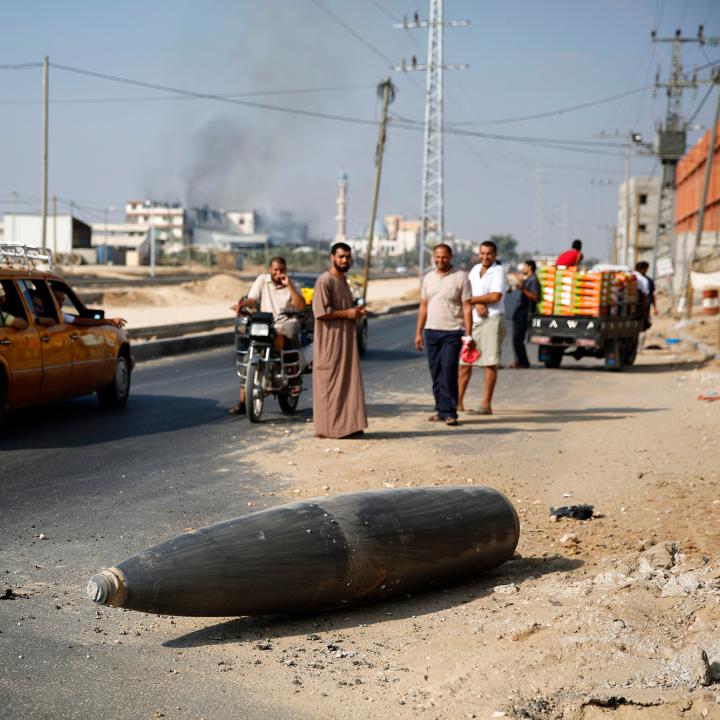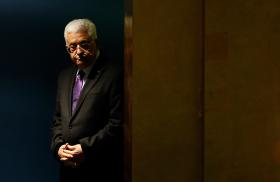

Hamas is using the rubble and unexploded ordnance from Israeli strikes to re-arm, and new, bold ideas are needed to prevent the continuation of recurring cycles of violence and rearmament.
Regardless of Israeli, international, Arab, and even some Palestinians’ desire to see Hamas relinquish its armaments, the group will continue its pursuit of more rockets and more tunnels. Connecting Gaza’s reconstruction and long-term prosperity to disarmament is a repetitive mistake which has failed time and again to stabilize the Strip and prevent confrontations with the Israeli military.
Amidst the ubiquitous photos of damage and destruction in Gaza due to the most recent round of Israeli bombardment, several images show a not-so-uncommon scene in the Strip: large, unexploded bombs, mostly dropped by Israeli fighter jets, and some artillery shells lying in dense urban areas. To cope with the harshness of the circumstances, some Palestinians in the narrow Strip treat these bombs as temporary souvenirs, taking sarcastic pictures with them, or even drawing artwork on large ones. Ultimately however, teams from the Gaza fire department arrive with cranes and rudimentary tools to collect such munitions and dispose of them outside the crowded population centers.
Unknown to many is that once such munitions are collected, teams from Hamas’s armed wing, the Qassam Brigades (Q.B.), will arrive at various locations storing the unexploded ordnances and will take large numbers of them to workshops for recycling the explosive materials inside them. These raw substances are subsequently used to create rocket propellers and explosive warheads for rockets. It is estimated that there are thousands of pounds of such materials throughout the Strip left behind from the latest Israeli military operation. Now, they could be ready to be used by the very group that was targeted with them to prepare for future attacks against the very entity that used them in the first place.
Furthermore, the destruction of large residential towers, homes, roads, and various infrastructure targets in the Strip left behind many materials that can be recycled by the Q.B. These include electrical wires, metal pipes, sheet metal, rebar steel, and crumbled concrete, all of which can and have been used by the group to expand their extensive network of tunnels, referred to as the “Hamas Metro” by Israeli officials, as well as the production of rocket tubes and other explosive devices. The irony here is that the IDF’s operation indirectly provided Hamas with materials that are otherwise strictly monitored or forbidden altogether in Gaza.
Some might feel reassured by Egypt’s years-long crippling destruction of smuggling tunnels along the border with Gaza. Cairo takes a harsh ideological stance against Hamas and has worked hard to combat its smuggling operations with Bedouin tribes and militant cells operating in the vicinity of the Strip. However, and even if reduced to a trickle, it would be virtually impossible for Egypt’s army to fully stop weapons being smuggled across Sinai’s vast expanses. Hamas, with Iranian and Hezbollah logistical support, has mastered the art of sneaking in critical shipments coming from Libya, or transiting via Sudan, using generous cash payments to tribes or even bribes to Egyptian military officers.
Parallel with the group’s ongoing armament is a mammoth effort to dig offensive and logistical tunnels throughout Gaza and near the borders with Israel. The group benefits tremendously from the Strip’s mass unemployment to hire diggers for as little as $30 dollars a day, often employed in small, disconnected teams to maximize secrecy. This effort is likely to be supercharged now with the availability of rebar and recyclable concrete that are used to reinforce tunnel structures.
Major military campaigns in Gaza are always followed by two interconnected themes: reconstruction, and the prevention of rearmament. The 2014 war saw the introduction of the Gaza Reconstruction Mechanism which has been overseen by the UN Office of Project Services (UNOPS). The process made it virtually impossible for Hamas to acquire raw cement, wood, gravel, rebar, fertilizers, or other materials that could be used in rearmament. Despite the strictest of monitoring regimes and, as is the case after every operation, the group’s tactics and arsenal grows stronger, its rockets obtain longer ranges, tunnels become more complex, repeating a cycle, often to Hamas’ advantage.
The people of Gaza are the biggest losers in every such operation. Israel’s infrastructure and military power enable it to minimize the loss of life and property during operations against Gaza, while the Palestinian residents of the coastal enclave are afforded no such privileges. Gazans cannot affect the political discourse impacting their very lives, nor can they influence or change the leaderships in the Strip or the West Bank. They are chronically traumatized from blockade, wars, shortages, psychological damage, and years of neglect. The other big loser is Israel’s stability and international standing. Israel, regardless of its departure from Gaza in 2005 and despite due criticism of how Palestinians’ civil affairs are managed by their leaders, bears great responsibility in addressing the sheer degradation of Gazans’ quality of life. It must address its security concerns while allowing for a radically different approach to improve conditions and circumstances of an increasingly desperate population, directly and indirectly.
There is no shortage of opinions and analysis of what caused the latest round of fighting between Israel and Hamas in Gaza. What is in short supply are bold and courageous new ideas, visions, proposals, and approaches to address the security threats posed by Hamas’ persistent adoption of armed struggle, while allowing for Gazans to have a peaceful and prosperous life. The only way to significantly delay or outright prevent a future confrontation and develop true deterrence, like that achieved with Hezbollah in Lebanon, is to overwhelm the Strip with development.
Letting Gazans travel freely, allowing for robust, even if monitored, trade and commerce, establishing internationally managed ports for travel and business, and supporting critical infrastructure to ensure the availability of electricity, water, sewage treatment, and quality medical care will cumulatively create decent quality of life, resulting in a high political and social barrier to Hamas’ utilization of its arsenal in future crises. Hezbollah’s own Hassan Nasrallah admitted after the 2006 war that if he had known the scale of destruction which his groups’ actions resulted for Lebanon’s infrastructure and economy, he would not have ordered the attack against the Israeli border patrol that in turn sparked the 34-day conflict.
According to military officials, Israel’s Iron Dome missile defense system has a successful interception rate of up to 90% in its engagements with rockets fired from Gaza. Furthermore, the IDF is working on a laser interception system which would be much more effective and cheaper to operate than the Iron Dome and could be operational within a decade. This impending advancement, coupled with continuous evolution of tunnel detection systems and the development an underground anti-tunnel protective wall, would make military threats from Gaza containable. Though psychologically menacing, the tactical damage and impact of Hamas’ rockets and offensive tunnels could become negligible within a few years.
In 2017, I attended a lecture given by former U.S. Secretary of State, Condoleezza Rice, who discussed contemporary challenges of dealing with Russia. She spoke of her admiration for the history and resilience of Russians, saying that “there has to be a way to isolate Putinism without isolating the Russian people.” The wellbeing and prosperity of the Palestinian people in Gaza should never be sidelined or deprioritized when implementing security measures, no matter how necessary.


